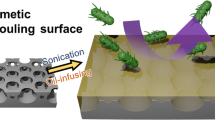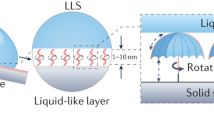Abstract
Creating a robust synthetic surface that repels various liquids would have broad technological implications for areas ranging from biomedical devices and fuel transport to architecture but has proved extremely challenging1. Inspirations from natural nonwetting structures2,3,4,5,6, particularly the leaves of the lotus, have led to the development of liquid-repellent microtextured surfaces that rely on the formation of a stable air–liquid interface7,8,9. Despite over a decade of intense research, these surfaces are, however, still plagued with problems that restrict their practical applications: limited oleophobicity with high contact angle hysteresis9, failure under pressure10,11,12 and upon physical damage1,7,11, inability to self-heal and high production cost1,11. To address these challenges, here we report a strategy to create self-healing, slippery liquid-infused porous surface(s) (SLIPS) with exceptional liquid- and ice-repellency, pressure stability and enhanced optical transparency. Our approach—inspired by Nepenthes pitcher plants13—is conceptually different from the lotus effect, because we use nano/microstructured substrates to lock in place the infused lubricating fluid. We define the requirements for which the lubricant forms a stable, defect-free and inert ‘slippery’ interface. This surface outperforms its natural counterparts2,3,4,5,6 and state-of-the-art synthetic liquid-repellent surfaces8,9,14,15,16 in its capability to repel various simple and complex liquids (water, hydrocarbons, crude oil and blood), maintain low contact angle hysteresis (<2.5°), quickly restore liquid-repellency after physical damage (within 0.1–1 s), resist ice adhesion, and function at high pressures (up to about 680 atm). We show that these properties are insensitive to the precise geometry of the underlying substrate, making our approach applicable to various inexpensive, low-surface-energy structured materials (such as porous Teflon membrane). We envision that these slippery surfaces will be useful in fluid handling and transportation, optical sensing, medicine, and as self-cleaning and anti-fouling materials operating in extreme environments.
This is a preview of subscription content, access via your institution
Access options
Subscribe to this journal
Receive 51 print issues and online access
$199.00 per year
only $3.90 per issue
Buy this article
- Purchase on Springer Link
- Instant access to full article PDF
Prices may be subject to local taxes which are calculated during checkout




Similar content being viewed by others
References
Quéré, D. Wetting and roughness. Annu. Rev. Mater. Res. 38, 71–99 (2008)
Barthlott, W. & Neinhuis, C. Purity of the sacred lotus, or escape from contamination in biological surfaces. Planta 202, 1–8 (1997)
Gao, X. F. & Jiang, L. Water-repellent legs of water striders. Nature 432, 36 (2004)
Hansen, W. R. & Autumn, K. Evidence for self-cleaning in gecko setae. Proc. Natl Acad. Sci. USA 102, 385–389 (2005)
Gao, X. F. et al. The dry-style antifogging properties of mosquito compound eyes and artificial analogues prepared by soft lithography. Adv. Mater. 19, 2213–2217 (2007)
Epstein, A. K., Pokroy, B., Seminara, A. & Aizenberg, J. Bacterial biofilm shows persistent resistance to liquid wetting and gas penetration. Proc. Natl Acad. Sci. USA 108, 995–1000 (2011)
Quéré, D. Non-sticking drops. Rep. Prog. Phys. 68, 2495–2532 (2005)
Tuteja, A. et al. Designing superoleophobic surfaces. Science 318, 1618–1622 (2007)
Tuteja, A., Choi, W., Mabry, J. M., McKinley, G. H. & Cohen, R. E. Robust omniphobic surfaces. Proc. Natl Acad. Sci. USA 105, 18200–18205 (2008)
Nguyen, T. P. N., Brunet, P., Coffinier, Y. & Boukherroub, R. Quantitative testing of robustness on superomniphobic surfaces by drop impact. Langmuir 26, 18369–18373 (2010)
Bocquet, L. & Lauga, E. A smooth future? Nature Mater. 10, 334–337 (2011)
Poetes, R., Holtzmann, K., Franze, K. & Steiner, U. Metastable underwater superhydrophobicity. Phys. Rev. Lett. 105, 166104 (2010)
Bohn, H. F. & Federle, W. Insect aquaplaning: Nepenthes pitcher plants capture prey with the peristome, a fully wettable water-lubricated anisotropic surface. Proc. Natl Acad. Sci. USA 101, 14138–14143 (2004)
Ahuja, A. et al. Nanonails: a simple geometrical approach to electrically tunable superlyophobic surfaces. Langmuir 24, 9–14 (2008)
Li, Y., Li, L. & Sun, J. G. Bioinspired self-healing superhydrophobic coatings. Angew. Chem. Int. Ed. Engl. 49, 6129–6133 (2010)
Lee, C. & Kim, C. J. Underwater restoration and retention of gases on superhydrophobic surfaces for drag reduction. Phys. Rev. Lett. 106, 014502 (2011)
Cassie, A. B. D. & Baxter, S. Wettability of porous surfaces. Trans. Faraday Soc. 40, 0546–0550 (1944)
Cassie, A. B. D. & Baxter, S. Large contact angles of plant and animal surfaces. Nature 155, 21–22 (1945)
Shafrin, E. G. & Zisman, W. A. Constitutive relations in the wetting of low energy surfaces and the theory of the retraction method of preparing monolayers. J. Phys. Chem. 64, 519–524 (1960)
Bauer, U. & Federle, W. The insect-trapping rim of Nepenthes pitchers: surface structure and function. Plant Signal. Behav. 4, 1019–1023 (2009)
Federle, W., Riehle, M., Curtis, A. S. G. & Full, R. J. An integrative study of insect adhesion: mechanics and wet adhesion of pretarsal pads in ants. Integr. Comp. Biol. 42, 1100–1106 (2002)
Wenzel, R. N. Resistance of solid surfaces to wetting by water. Ind. Eng. Chem. 28, 988–994 (1936)
Courbin, L. et al. Imbibition by polygonal spreading on microdecorated surfaces. Nature Mater. 6, 661–664 (2007)
de Gennes, P.-G., Brochard-Wyart, F. & Quéré, D. Capillarity and Wetting Phenomena: Drops, Bubbles, Pearls, Waves 15–18 (Springer, 2003)
Pokroy, B., Epstein, A. K., Persson-Gulda, M. C. M. & Aizenberg, J. Fabrication of bioinspired actuated nanostructures with arbitrary geometry and stiffness. Adv. Mater. 21, 463–469 (2009)
Chen, W. et al. Ultrahydrophobic and ultralyophobic surfaces: some comments and examples. Langmuir 15, 3395–3399 (1999)
Delmas, M., Monthioux, M. & Ondarcuhu, T. Contact angle hysteresis at the nanometer scale. Phys. Rev. Lett. 106, 136102 (2011)
Furmidge, C. G. Studies at phase interfaces. 1. Sliding of liquid drops on solid surfaces and a theory for spray retention. J. Colloid Sci. 17, 309–324 (1962)
Ishino, C., Reyssat, M., Reyssat, E., Okumura, K. & Quéré, D. Wicking within forests of micropillars. Europhys. Lett. 79, 56005 (2007)
Nakajima, A., Fujishima, A., Hashimoto, K. & Watanabe, T. Preparation of transparent superhydrophobic boehmite and silica films by sublimation of aluminum acetylacetonate. Adv. Mater. 11, 1365–1368 (1999)
Acknowledgements
T.-S.W. acknowledges funding support from the Croucher Foundation Postdoctoral Fellowship. We thank K. E. Martin for help with the drop impact test. We also thank J. C. Weaver and P. Allen for help in manuscript preparation. The work was supported partially by the AFOSR MURI award FA9550-09-1-0669-DOD35CAP (optical properties), and ARO MURI award W911NF-09-1-0476 (robustness and self-repair). We acknowledge the use of the facilities at the Harvard Center for Nanoscale Systems supported by the NSF under award ECS-0335765.
Author information
Authors and Affiliations
Contributions
T.-S.W. and J.A. conceived the research. J.A. supervised the research. T.-S.W., S.H.K. and S.K.Y.T. designed the experiments. T.-S.W. carried out surface wettability characterizations. S.H.K. prepared samples and conducted data analysis. T.-S.W., S.H.K. and S.K.Y.T. carried out surface morphology characterizations. T.-S.W. and S.H.K. carried out drop impact tests and ice experiments. E.J.S. and T.-S.W. carried out the high pressure and optical transmission measurements. B.D.H. and T.-S.W. carried out blood compatibility tests. T.-S.W., S.H.K., A.G. and J.A. wrote the manuscript.
Corresponding author
Ethics declarations
Competing interests
The authors declare no competing financial interests.
Supplementary information
Supplementary Information
The file contains Supplementary Methods, Supplementary Discussion, Supplementary Tables 1-6 and Supplementary Figures 1-8 with legends. (PDF 1076 kb)
Supplementary Movie 1
This movie demonstrates the liquid repellency of a SLIPS under extremely high pressure (˜675 atm) environment. As seen from the movie, a droplet of decane (˜ 4 µL) retains the ability to slide on the SLIPS when the surface is tilted less than 10 degrees relative to the horizontal plane. (MOV 3478 kb)
Supplementary Movie 2
This movie demonstrates the fast recovery of the liquid-repellent function of a SLIPS after critical physical damage. As seen from the movie, the crude oil droplet is pinned on a nanostructured superhydrophobic surface (without lubricating fluid), while the droplet maintains its mobility on the SLIPS. Extra-light crude oil (from Appalachian Basin, USA) was used as the test liquid for demonstration. (MOV 7249 kb)
Supplementary Movie 3
This movie demonstrates the excellent oil repellency of a SLIPS, as compared to other textured and non-textured surfaces. As seen from the movie, oils slide faster on the SLIPS leaving behind no noticeable oil, whereas oil stains are observed on the other surfaces. Light crude oil (from Louisiana, USA) was used as the test liquid for demonstration. This movie corresponds to Fig. 4a in the main text. (MOV 5108 kb)
Supplementary Movie 4
This movie demonstrates the excellent blood repellency of a SLIPS, as compared to other textured and non-textured surfaces. As seen from the movie, no noticeable blood is left on the SLIPS, whereas blood stains are observed on the other surfaces. Sheep blood (HemoStat Laboratories, CA) was used as the test fluid. This movie corresponds to Fig. 4b in the main text. (MOV 4705 kb)
Supplementary Movie 5
This movie demonstrates the excellent ice-repellency of a SLIPS, as compared to a nanostructured surface. As seen from the movie, an ice block (formed from a frozen water droplet of ˜100 µL at –4 °C and ˜45% relative humidity) slides on the SLIPS under the influence of gravity. In comparison, an ice block of the same volume remains strongly pinned on a superhydrophobic nanostructured surface without a lubricating layer. This movie corresponds to Fig. 4c in the main text. (MOV 4671 kb)
Supplementary Movie 6
This movie demonstrates the ability of a SLIPS to repel an insect and a highly viscous fluid (i.e., strawberry jam). As seen from the movie, a carpenter ant is unable to stay on our synthetic slippery surface—a direct mimicry on the insect-trapping capability of pitcher plants in nature. This movie corresponds to Fig. 4d in the main text. (MOV 7307 kb)
Supplementary Movie 7
This movie demonstrates the self-cleaning ability of a SLIPS. As seen from the movie, carbon dust is seeded onto the SLIPS and can be easily removed by sliding an ethanol droplet across the surface. This movie corresponds to Fig. S7a in the Supplementary Information. (MOV 5003 kb)
Rights and permissions
About this article
Cite this article
Wong, TS., Kang, S., Tang, S. et al. Bioinspired self-repairing slippery surfaces with pressure-stable omniphobicity. Nature 477, 443–447 (2011). https://doi.org/10.1038/nature10447
Received:
Accepted:
Published:
Issue Date:
DOI: https://doi.org/10.1038/nature10447
This article is cited by
-
Droplet slipperiness despite surface heterogeneity at molecular scale
Nature Chemistry (2024)
-
Structural engineered living materials
Nano Research (2024)
-
Experimental study on the impact behaviors of a water drop on immiscible oil surfaces: bouncing, compound central jet formation and crater evolution
Experiments in Fluids (2024)
-
Entropic repulsion of cholesterol-containing layers counteracts bioadhesion
Nature (2023)
-
Droplet attraction and coalescence mechanism on textured oil-impregnated surfaces
Nature Communications (2023)
Comments
By submitting a comment you agree to abide by our Terms and Community Guidelines. If you find something abusive or that does not comply with our terms or guidelines please flag it as inappropriate.



